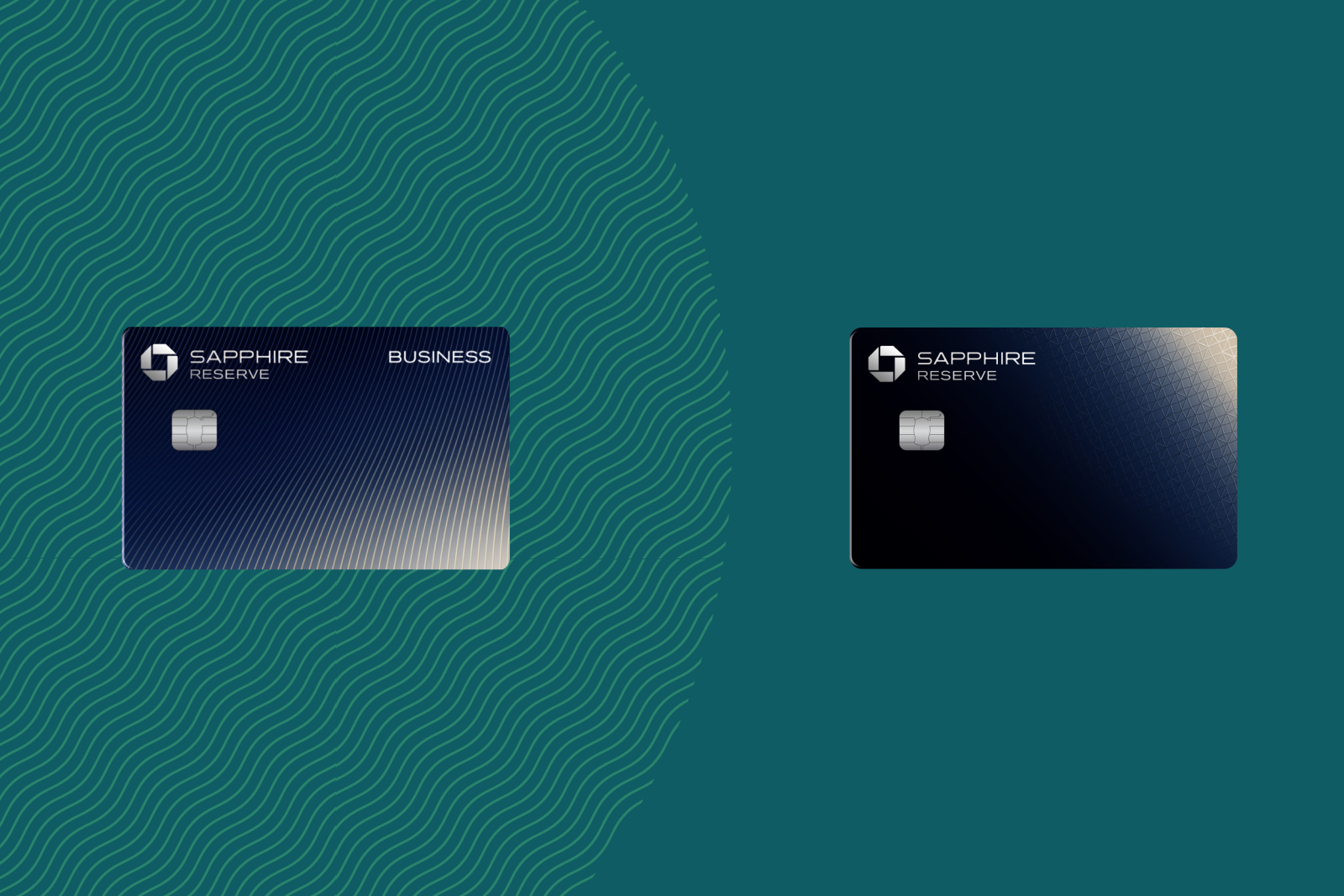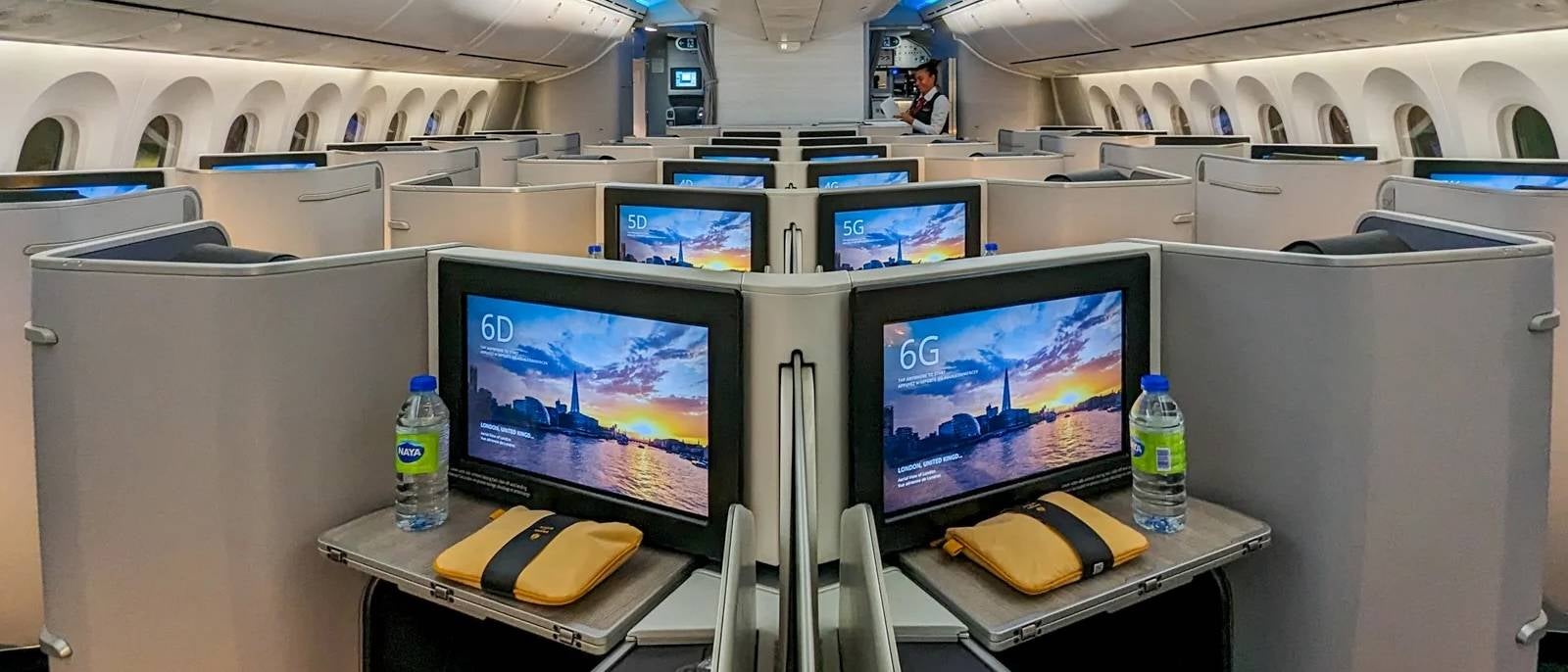Chase now has two flagship premium card offerings, one personal and one business. The bank recently introduced the Chase Sapphire Reserve for Business℠ (see rates and fees) and refreshed the popular Chase Sapphire Reserve® (see rates and fees) with new benefits. Both cards carry a whopping $795 annual fee but have various premium travel perks, useful statement credits and airport lounge access.
Let’s compare these two cards and see which is right for you.
Comparison of the Sapphire Reserve vs. Sapphire Reserve for Business
| Card | Sapphire Reserve | Sapphire Reserve for Business |
|---|---|---|
| Welcome offer | Earn 100,000 bonus points and a $500 Chase Travel℠ credit after spending $5,000 on purchases in the first three months from account opening. | Earn 200,000 bonus points after spending $30,000 on purchases in the first six months from account opening. |
| Annual fee | $795 | $795 |
| Earning rates |
|
|
| Statement credits |
|
|
Sapphire Reserve vs. Reserve for Business welcome offer
With both cards having $795 annual fees, the first thing you might look at is the welcome offers. Both cards have industry-leading welcome offers that can provide thousands of dollars in value when redeemed for travel.
For a limited time, new applicants for the Sapphire Reservecan earn 100,000 bonus points and a $500 Chase Travel credit after spending $5,000 on purchases within the first three months from account opening. Based on TPG’s June 2025 valuation of Chase Ultimate Rewards points at 2.05 cents each, this offer is worth up to $2,550.
On the other hand, new Sapphire Reserve for Business applicants can earn 200,000 bonus points after spending $30,000 on purchases in the first six months after account opening. Based on TPG’s June 2025 valuations, this offer is worth $4,100.
The welcome offer on the Sapphire Reserve is much more attainable, as the minimum spending requirement is much lower at $5,000 over three months. However, those with high business expenses can get more value from the Sapphire Reserve for Business’ larger points bonus.
Winner: Chase Sapphire Reserve for Business. Its welcome offer is worth almost double that of the Sapphire Reserve; however, it requires six times the minimum spending amount of the Sapphire Reserve.
Related: The best credit card welcome bonuses of the month
Sapphire Reserve vs. Reserve for Business benefits
Both cards offer numerous benefits, including statement credits, lounge access and travel protections.

Daily Newsletter
Reward your inbox with the TPG Daily newsletter
Join over 700,000 readers for breaking news, in-depth guides and exclusive deals from TPG’s experts
Here’s an overview of the benefits offered on both cards:
| Benefit | Sapphire Reserve | Sapphire Reserve for Business |
|---|---|---|
| Annual statement credits and benefits |
|
|
| Lounge access |
|
|
| Travel protections |
|
|
| Hotel perks |
|
|
| Unlockable benefits | After spending $75,0000 or more in a year, you unlock:
|
After spending $120,000 or more in a year, you unlock:
|
Most of the cards’ benefits, like the airport lounge access, the annual $300 travel credit and the travel protections if your travels go awry, overlap.
There are a few differences between the benefits the cards offer. The Sapphire Reserve has more lifestyle-focused benefits like dining, entertainment and streaming credits. In contrast, the Sapphire Reserve for Business credits are more catered toward business owners, with credits focused on hiring and productivity.
Additionally, you can unlock the same elite benefits on the Sapphire Reserve with $45,000 less in spending. However, you will sacrifice $250 in The Shops at Chase credit. This is Chase’s new online shopping experience with products from Dyson, Tumi and other high-end brands.
It’s important to note that current Sapphire Reserve cardholders will not have access to new benefits and credits until Oct. 26, 2025.
Winner: Chase Sapphire Reserve. It offers slightly more statement credits that are easier to use for most consumers. However, the Chase Sapphire Reserve for Business can be excellent for small-business owners who already spend with ZipRecruiter and Google Workspace.
Related: The best premium credit cards: A side-by-side comparison
Earning points on the Sapphire Reserve vs. Sapphire Reserve for Business
Both cards earn ultravaluable Chase Ultimate Rewards points in a variety of bonus categories.
With the Sapphire Reserve, you’ll earn:
- 10 points per dollar spent on Peloton equipment and accessory purchases of $150 or more (through Dec. 31, 2027), with a maximum of 50,000 points
- 8 points per dollar spent on purchases made through Chase Travel, including The Edit
- 5 points per dollar spent on Lyft rides through Sept. 30, 2027
- 4 points per dollar spent on flights and hotels booked directly
- 3 points per dollar spent on dining worldwide
- 1 point per dollar spent on all other purchases
Meanwhile, the Sapphire Reserve for Business earns:
- 8 points per dollar spent on Chase Travel purchases
- 5 points per dollar spent on eligible Lyft rides through Sept. 30, 2027
- 4 points per dollar spent on flights and hotels booked directly
- 3 points per dollar spent on advertising purchases made with social media sites and search engines
- 1 point per dollar spent on all other purchases
It’s important to note that there is no spending cap on the 3 points per dollar spent on advertising, unlike other Chase business cards, like the Ink Business Preferred® Credit Card (see rates and fees), which has a $150,000 spending cap.
Both cards have the same earning rates on Chase Travel purchases and flights and hotels booked directly. The Sapphire Reserve offers bonus points on dining and Peloton purchases. However, business owners who spend heavily on online advertising will appreciate the unlimited bonus earnings available with the Sapphire Reserve for Business.
Winner: Tie. Both cards have similar earning rates with some key differences. Think through your daily spending to find the best fit for your wallet.
Related: Is the Chase Sapphire Reserve worth the annual fee?
Redeeming points on the Sapphire Reserve vs. Sapphire Reserve for Business
Both cards offer multiple ways to redeem your points, but the best value redemption will be to transfer to one of Chase’s transfer partners. You can redeem your points for cash back, gift cards, dining and experiences through the Ultimate Rewards portal. You can also take advantage of Chase’s Pay Yourself Back feature, where you can get higher value from your points to cover eligible purchases.
Additionally, Chase has introduced Points Boost. Points can be used to book travel directly through Chase Travel at a value of up to 2 cents per point, depending on the card and the specific redemption (see your rewards program agreement for full details). Here are a few things to note about Points Boost:
- Points Boost offer rates depend on the airline and the class you book (basic economy is excluded). The airlines will vary and change, but from the start, it seems like the airlines eligible for Points Boost are all Chase transfer partners.
- Premium cabins will offer higher redemption rates.
- Points redeemed for booking a property that’s part of The Edit will be redeemed at 2 cents per point.
- For Sapphire Reserve cardholders approved before June 23, 2025, all points earned before Oct. 26, 2025, can be redeemed at 1.5 cents per point via Chase Travel, regardless of the airfare class or hotel property, or at up to 2 cents with Points Boost. The higher redemption rate will automatically be selected for you for two years.
- All non-Points Boost-eligible Chase Travel purchases can be redeemed at a rate of 1 cent per point.
Winner: Tie. Both cards offer the same redemption options and access to Chase’s Points Boost perk.
Transferring points on the Sapphire Reserve vs. Sapphire Reserve for Business
You can transfer Ultimate Rewards points to Chase’s extensive roster of 14 airline and hotel partners. Transferring points lets you get maximum value from them, and you can often exceed TPG’s June 2025 valuation of 2.05 cents per point. These transfer partners are the same for both Sapphire Reserve cards.
Some popular partners include Air Canada Aeroplan, Air France-KLM Flying Blue, United MileagePlus and World of Hyatt.
Danyal Ahmed, a cards writer at TPG, frequently transfers his points to Air Canada Aeroplan because of its phenomenal award charts. For example, he recently transferred 20,000 points to book a multicity trip around Europe, all in business class, with Swiss and Turkish Airlines.
Winner: Tie. Both cards share the same transfer partners and rates.
Related: How to redeem Chase Ultimate Rewards points for maximum value
Should I get the Sapphire Reserve or the Sapphire Reserve for Business?
If you aren’t a business owner and prefer earning bonus points on everyday spending categories like dining, you should opt for the Sapphire Reserve. Meanwhile, if you’re a business owner looking for premium benefits and bonus points on advertising, you should opt for the Sapphire Reserve for Business.
However, if you’re a business owner and torn between which card to get, you could get both cards and receive both welcome bonuses. If you decide to do this, ensure you time your applications so you have enough time to earn both bonuses.
Bottom line
The Sapphire Reserve has been revamped with a higher annual fee, but it also now has numerous credits and benefits to give cardholders more value. If you’re looking for an easy-to-use travel credit, lounge access and a plethora of other benefits, this option is right for you.
Meanwhile, the Sapphire Reserve for Business is Chase’s first foray into the premium business card market. Its benefits and statement credits are catered to small-business owners who value premium travel benefits. There’s plenty of overlap, but it’s worth comparing the two to see which is the best fit for your wallet.
Apply here: Chase Sapphire Reserve
Apply here: Chase Sapphire Reserve for Business















